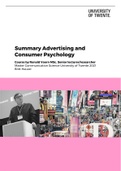Summary
Summary Advertising and Consumer Psychology 2021 by Ronald Voorn
- Module
- Institution
Summary of the course Advertising and Consumer Psychology by Ronald Voorn at the Master Communication Science at the University of Twente. This summary contains all the information from the lectures and extra materials.
[Show more]












